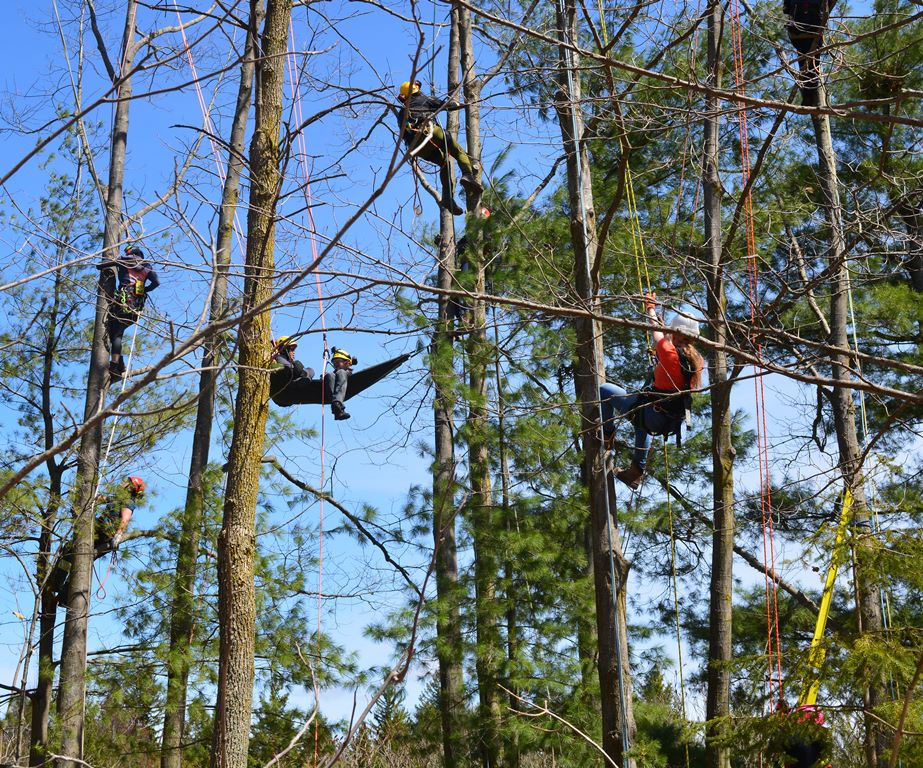17 The “Pertnear”
It's Okay to Fail
By Tom Mikel, Urban Forestry & Arboriculture, Fleming College
When would you say your deepest learning occurred? It probably wasn’t when you got a question right on a multiple choice test. More likely it was when you made a big mistake. We have all traveled a crooked path to get where we are and for the lucky among us, this includes post-secondary education. It is during this time that we as teachers hope to help pry open the minds of our students and cram their brains full of everything to do with the subject at hand. But how much do they actually retain? How much did you retain from everything someone tried to pass to you throughout your studies?
Most of us have also attended some classes in the School of Hard Knocks. Probably some of your deepest learning happened here. If you are like me, you’ve had lots of pertnears in your day. Where I come from, a pertnear is what some with clearer diction may call a pretty near. In other words, you almost got it, but not quite.
When I think back I realize it’s been the pertnears that taught me the most. Failing is often not the worst thing that could happen. It might even be the best thing that could happen to a certain person at a certain time. Failing teaches us we were wrong this time, but if we fail in a safe and supportive environment we learn from that and grow from it.
Let me tell you about one of my pertnears. I took Arboriculture in college. One of the things I learned, via pertnear, was that the figure ‘8’ knot is removed from the end of a rope before being pulled out of the tree. My error was done in a safe and supportive environment, but there was a consequence. Now, whenever I need to recall this tidbit of learning, the memory of having to re-climb the tree to retrieve my stuck rope is auto-replayed for me by my brain. Frankly, I think my brain quite enjoys reminding me of it. I never did that again.
In everyday life we also have those same pertnears; shut the power off before rewiring a plug, don’t lick frost on a pole, and if the oil light is on in your car, don’t ignore it. We learn from our mistakes and most times we don’t forget them. I often think of my pertnears and I realize that I know as much as I do because I did it all wrong first, reflected upon it and learned how to fix it.
So why punish students for failure? I get that we have to have a means to approve who is successful and ready to go on, and grading is a means of measuring that. But remember, there is a difference between a flat out failure and a pertnear. Of course some students are going to be ‘pertfar‘ for whatever reason and won’t be able to pass the course A pertnear, is that student who does try and just maybe cannot quite connect the pieces, yet. They can and will be successful. They just need a chance to do it wrong first, reflect and then improve.
This may not work all the time. There are some things that must be done correctly 100% of the time. A course I teach, Basic Tree Climbing in the Arboriculture program at Fleming College, is a good example of this. In regards to safety there is no room for pertnears. In our tree climbing courses students must achieve 100% on tying the knots that are part of their climbing system before they can climb a tree. They must be 100% in regards to safety. No pertnears allowed there.
But after that, some pertnears can occur. Tree climbing is about working safely first and foremost, but also efficiently and in an energy conserving manner. As students progress and begin climbing there are many tricks of the trade which help to improve timing and efficiency. This is where the tree climbing pertnears can be valuable learning experiences.
When teaching tree climbing, I demonstrate the task to the students and then they practice doing it. Each task throughout the semester is more challenging. This gives ample time for the learners to go out, “pertnear” it, and then try again until they’ve got it. In fact, demonstrating the technique once before they attempt the task is not that effective. Every tree is different so there is a lot of variance in executing these skills from tree to tree. I see the greatest improvement when the task is demonstrated again after students have practiced. This is when conversations come up among students on the ground. They watch me and their peers with much more intent and care as we climb. They watch the climbing direction, lanyard positioning, and how the climbing line is advanced. All of these little things are what helps them go from pertnear to there.
So although it may not always be safely applicable, celebrating the pertnear is an excellent mindset to have as a teacher and as a learner. It allows failure, in a safe and controlled environment. It allows reflection. It gives us the courage to try again. This is a rewarding method of learning for students that just may instill learning experiences that will stick with them. In my teaching I like to try to help make sure our learning environment, and even the culture of our learning community, is a place where the pertnear is a cause for celebration and that we all want to just get up and try again.

Featured image from the Women in Trees Conference at Frost Campus in Lindsay, Ontario by Leigh Mceachran, 2017


